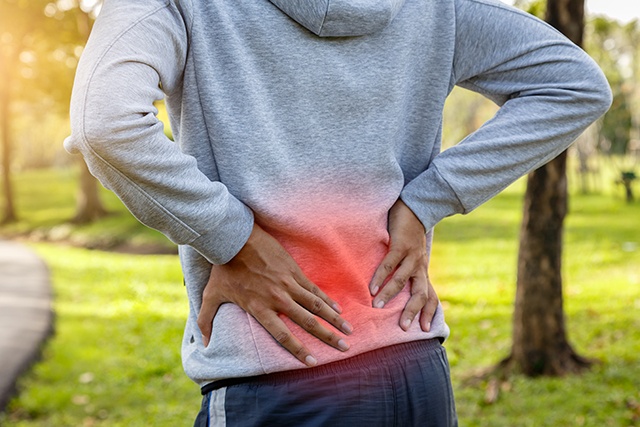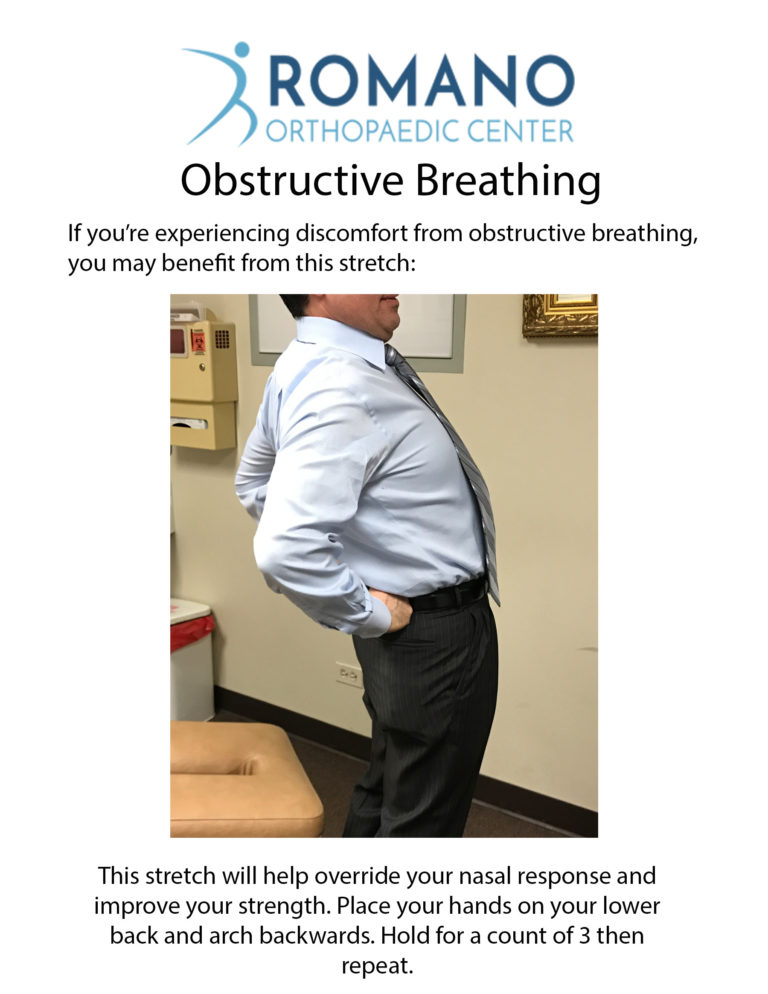
Who would have thought that lower back pain when breathing is linked to sinus congestion and nasal blockage?
I have found that some neck and back pain, along with associated weakness and balance problems, can be improved by eliminating sinus congestion for clear nasal breathing. The body has a great capacity to compensate for injuries, and sometimes the presenting symptoms are not the reasons why your lower back hurts when inhaling. Only by finding and treating the root cause of the pain can one truly be healed and avoid further injury.
By examining hundreds of patients, I have observed four patterns of neck and lower back pain that are associated with weakness elsewhere and aggravated by nasal blockage and sinus congestion on the side of the pain. This has never been described adequately before.
Types of Neck, Upper and Lower Back Pain While Breathing
1) Lower back pain at the sacral-iliac (SI) joint (near the buttocks) is associated with weakness in extension of the opposite elbow. Therefore, when the right nasal passage is completely congested and blocked, there is automatically irritation of the right SI joint with associated weakness in the left triceps (straightening out the elbow).
2) Pain at the L2 level (lower back) is associated with same-sided weakness of hip flexion (raising the hip while seated, which is well known), and shoulder extension (raising the shoulder straight ahead, which is new).
3) Upper back pain in the mid-thoracic region is associated with same-sided weakness of shoulder abduction (raising the shoulder to the side) with the palms parallel to the floor.
4) Middle neck pain at the C5 level is associated with same-sided weakness of shoulder abduction with the thumbs pointing to the floor.
Although I routinely find this correlation, I can only find one Australian article that supports this finding: “Disorders of breathing and continence have a stronger association with back pain than obesity and physical activity.”
Completely blocked nasal passages, manually, will produce all four pain-patterns simultaneously; however, I never find this clinically. What I find routinely is that only one pain pattern is present at a time and it is associated with partial nasal obstruction. I also find that these pain patterns can fluctuate. I believe that this may be related to the nasal cycle. (The nasal cycle is the normal alternating partial congestion and decongestion of the nasal cavities produced by swelling of the nasal turbinates – bony projections covered by erectile tissue.) Normally this cycle goes unnoticed unless a deviated septum or excessive inflammation from diet, allergies and/or infection completely obstructs the nasal cavity.
So far, I have found the following five ways of reversing the above patterns, thus relieving pain, improving strength, and restoring balance.
Treatment for Pain in Lower Back When Breathing
Manipulation
Manipulation of your Si joint, lower back, posterior ribs or first rib will relieve your pain, improve your strength and restore your balance. If that is the only source of your pain, you will be cured. However, if nasal congestion is also present, your symptoms will return with mouth breathing and you will have to keep on coming back for repeat manipulations.
Stretching
Below are simple stretching exercises that will help your back and neck pain.
SI joint stretching: Lie flat on your back, grab your knee from the affected side and pull it toward the opposite shoulder. Hold it for a slow count of 10. Then, place your leg flat and relax. Repeat this two more times. On the third set, do a yoga stretch. Keep holding your knee with the opposite arm and bring it across your body. Release your other arm from your knee and bring it out to your side. Again, hold it for a slow count of 10. Do this before you get out of bed in the morning, several times during the day and when you go to bed at night.
Lower back, L2, stretch: Stand behind a chair, holding its back for support. On the seat of another chair behind you, place the top of the foot on your affected side, and lean back until you feel a stretch on your thigh muscles and lower back. (If your knee hurts from bending, step forward a bit until it feels comfortable.) Next, bend your opposite knee to further stretch of your hip and lower back. Hold for a slow count of 10 and repeat two times. Repeat this stretch throughout the day.
Upper back stretch: Stand in a doorway or corner of the room with your shoulders flexed 90 degrees away from your body and your forearms resting on the wall. Lean forward, feeling the stretch in your upper back. Hold for a slow count of 10 and repeat two times. Repeat this stretch throughout the day.
Neck, C5, stretch: Looking straight ahead, stick your head straight out like a turtle. Now bring your head back and slowly lift our chin towards the ceiling as far back as you can go. Hold for a slow count of 10 and repeat two times. Repeat this stretch throughout the day.
Again, as long as you still have some nasal congestion, your symptoms will return with mouth breathing.
Spinal Rotation
Spinal rotational exercises will resolve the above patterns of pain, weakness, and imbalance for an extended period despite persistent nasal congestion. With your feet planted shoulder-width apart, rotate your body all the way to the right and then all the way to your left. Determine which way is easiest or which way you can go the furthest without pain and hold it in that direction for 40 seconds. Gently bounce at the end of your rotation to improve your stretch. Repeat this stretch three to five more times and then several times throughout the day.
Diaphragmatic Breathing
Diaphragmatic, abdominal, belly, or deep breathing is breathing that is done by contracting the diaphragm, a muscle attached to the spine and lower rib cage and located horizontally between the chest and stomach cavities. During this type of breathing, air enters the lungs and the belly expands rather than the chest.
I have found that the above patterns of pain, weakness and imbalance will resolve with diaphragmatic breathing. Diaphragmatic breathing exercises are used in yoga, tai chi, and meditation. When practiced regularly, it may lead to the relief or prevention of symptoms commonly associated with stress, which may include high blood pressure, headaches, stomach conditions, depression, anxiety, and others.
We stress diaphragmatic breathing in our therapy program to stabilize the spine while improving posture and cardio-respiratory fitness. A good exercise to strengthen your diaphragm is to lie on your back, with your legs elevated, while blowing up a balloon.
Obstructive Breathing Treatment
Along with the above treatment options, clearing your nasal passage is the best way to relieve above pain patterns for an extended period. Methods include:
Nasal strips. You see them advertised for snoring relief and worn by football players. These strips can be worn at nighttime and during exercise. They will open up your nasal passage, allowing you to sleep better, and may help relieve your lower back and upper arm pain.
Nasal rinse/Neti pot. With this, you pour a saline mixture in one nostril, tilt your head and allow it to run out of your opposite nostril. This is best used at bedtime and/or after you wake up.
Nasal sprays. Steroid (Flonase), anti-histamine and saline sprays can all open up your nasal passage and can be used as directed throughout your day, as needed.
If this does not improve your breathing and symptoms, you may need to see an ENT specialist and/or dental sleep specialist to help diagnose and correct your obstruction and relieve your pain.
N.B. The above work is based on the work of Dr. John Beck, an orthopaedic surgeon, who discovered the autonomic reflex testing (ANMRT) through trial and error over decades of practice. My nephew, Dr. Daniel Klauer, a dentist, introduced me to this concept years ago. He insisted that I learn ANMRT from Dr. Steven Olmos, a pioneering dentist with multiple TMJ and Sleep Apnea Centers around the world. He uses these techniques to make sure that his treatments for TMJ and sleep apnea are working.
Testing all of my patients in ANMRT over the last two years has completely changed the way I practice orthopaedics. I not only treat the presenting problem, but also now search for the root cause of each problem, facilitating a complete recovery and preventing future injuries. This is only the beginning. We have much more to learn.

